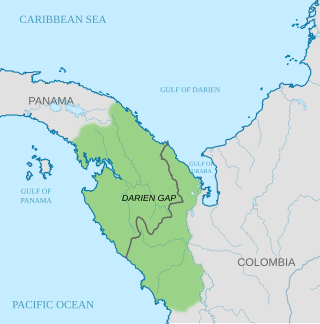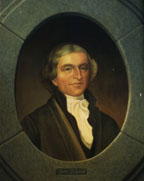
The Lewis and Clark Expedition, also known as the Corps of Discovery Expedition, was the United States expedition to cross the newly acquired western portion of the country after the Louisiana Purchase. The Corps of Discovery was a select group of U.S. Army and civilian volunteers under the command of Captain Meriwether Lewis and his close friend Second Lieutenant William Clark. Clark and 30 members set out from Camp Dubois, Illinois, on May 14, 1804, met Lewis and ten other members of the group in St. Charles, Missouri, then went up the Missouri River. The expedition crossed the Continental Divide of the Americas near the Lemhi Pass, eventually coming to the Columbia River, and the Pacific Ocean in 1805. The return voyage began on March 23, 1806, at Fort Clatsop, Oregon, and ended on September 23 of the same year.

Lieutenant Colonel Robert Peter Fleming was a British adventurer, journalist, soldier and travel writer. He was the elder brother of Ian Fleming, creator of James Bond.
Shangri-La is a fictional place in Asia's Kunlun Mountains (昆仑山), described in the 1933 novel Lost Horizon by English author James Hilton. Hilton portrays Shangri-La as a mystical, harmonious valley, gently guided from a lamasery, enclosed in the western end of the Kunlun Mountains. Shangri-La has become synonymous with any earthly paradise, particularly a mythical Himalayan utopia – an enduringly happy land, isolated from the world. In the novel, the people who live in Shangri-La are almost immortal, living hundreds of years beyond the normal lifespan and only very slowly aging in appearance.

The Darién Gap is a geographic region in the Isthmus of Darien or Isthmus of Panama connecting the North and South American continents within Central America, consisting of a large watershed, forest, and mountains in Panama's Darién Province and the northern portion of Colombia's Chocó Department.

John Ledyard was an American explorer and adventurer.

The Motorcycle Diaries is a posthumously published memoir of the Marxist revolutionary Ernesto "Che" Guevara. It traces his early travels, as a 23-year-old medical student, with his friend Alberto Granado, a 29-year-old biochemist. Leaving Buenos Aires, Argentina, in January 1952 on the back of a sputtering single cylinder 1939 Norton 500cc dubbed La Poderosa, they desired to explore the South America they only knew from books. During the formative odyssey Guevara is transformed by witnessing the social injustices of exploited mine workers, persecuted communists, ostracized lepers, and the tattered descendants of a once-great Inca civilization. By journey's end, they had travelled for a "symbolic nine months" by motorcycle, steamship, raft, horse, bus, and hitchhiking, covering more than 8,000 kilometres (5,000 mi) across places such as the Andes, the Atacama Desert, and the Amazon River Basin.

The genre of travel literature encompasses outdoor literature, guide books, nature writing, and travel memoirs.

Brandon Wilson is an American explorer and author of non-fiction travel narratives. A fellow of the Explorers Club, he has written books and essays about his extensive travels on foot as a pilgrim. In 2006, he pioneered the Templar Trail, recreating the route of the First Crusade from France to Jerusalem, as a pilgrimage path of peace.

Joseph Thomson was a British geologist and explorer who played an important part in the Scramble for Africa. Thomson's gazelle and Thomson's Falls, Nyahururu are named after him. Excelling as an explorer rather than an exact scientist, he avoided confrontations among his porters or with indigenous peoples, neither killing any native nor losing any of his men to violence. His motto is often quoted to be "He who goes gently, goes safely; he who goes safely, goes far."

Karl JohnAndersson was a Swedish explorer, hunter and trader as well as an amateur naturalist and ornithologist.

Russ Malkin is a British TV producer, director and founder of Big Earth Productions. He has created documentaries and formats for many broadcasters globally including BBC, ITV, Sky, National Geographic, Amazon and Discovery. Often working with high-profile personalities, Malkin has filmed across all seven continents in some of the harshest conditions on the planet. He is best known for the adventure travel documentaries Long Way Round, Long Way Down and Long Way Up with actors and keen motorcyclists Ewan McGregor and Charley Boorman. His recent work includes "Prince Harry in Africa", "David Beckham: For the Love of the Game" and three-part National Geographic documentary “Fiennes: Return to the Nile”.

Farthest South refers to the most southerly latitude reached by explorers before the first successful expedition to the South Pole in 1911. Significant steps on the road to the pole were the discovery of lands south of Cape Horn in 1619, Captain James Cook's crossing of the Antarctic Circle in 1773, and the earliest confirmed sightings of the Antarctic mainland in 1820. From the late 19th century onward, the quest for Farthest South latitudes became in effect a race to reach the pole, which culminated in Roald Amundsen's success in December 1911.

Overlanding or 4WD Touring is self-reliant overland travel to remote destinations where the journey is the principal goal. Typically, but not exclusively, it is accomplished with mechanized off-road capable transport where the principal form of lodging is camping, often lasting for extended lengths of time and spanning international boundaries.

A continent is any of several large geographical regions. Continents are generally identified by convention rather than any strict criteria. A continent could be a single landmass or a part of a very large landmass, as in the case of Asia or Europe. Due to this, the number of continents varies; up to seven or as few as four geographical regions are commonly regarded as continents. Most English-speaking countries recognize seven regions as continents. In order from largest to smallest in area, these seven regions are Asia, Africa, North America, South America, Antarctica, Europe, and Australia. Different variations with fewer continents merge some of these regions, examples of this are merging North America and South America into America, Asia and Europe into Eurasia, and Africa, Asia, and Europe into Afro-Eurasia.
Major explorations of Earth continued after the Age of Discovery. By the early seventeenth century, vessels were sufficiently well built and their navigators competent enough to travel to virtually anywhere on the planet by sea. In the 17th century, Dutch explorers such as Willem Jansz and Abel Tasman explored the coasts of Australia. Spanish expeditions from Peru explored the South Pacific and discovered archipelagos such as Vanuatu and the Pitcairn Islands. Luis Vaez de Torres chartered the coasts of New Guinea and the Solomon Islands, and discovered the strait that bears his name. European naval exploration mapped the western and northern coasts of Australia, but the east coast had to wait for over a century. Eighteenth-century British explorer James Cook mapped much of Polynesia and traveled as far north as Alaska and as far south as the Antarctic Circle. In the later 18th century, the Pacific became a focus of renewed interest, with Spanish expeditions, followed by Northern European ones, reaching the coasts of northern British Columbia and Alaska.

Allan Karl is an American author, adventurer and speaker. He is most known for travelling around the world on his motorcycle and subsequently writing the book, Forks: A Quest for Culture, Cuisine and Connection.
Major Levison James Wood VR is a British Army officer and explorer. He is best known for his extended walking expeditions in Africa, Asia and Central America. He has also undertaken numerous other overland journeys, including a foot crossing of Madagascar and mountain climbing in Iraq. He documents his journeys through books, documentaries and photography.

Helen (Armstrong) Schreider and Frank Schreider were explorers in the mid-20th century, known for traveling by amphibious jeep. National Geographic hired them after their first independent journey from Alaska to Tierra del Fuego (1954–56). They were the first people to travel the length of the Americas solely by means of their own power. They completed six additional expeditions through National Geographic, working freelance at first and later as foreign editorial staff, for fifteen years, from 1956 to 1970. They worked as a team and lived for periods of time in about 50 countries on five continents. Helen and Frank Schreider were known for their ability to write, photograph and film within the cultures they visited. They wrote three books, six major articles for National Geographic, and contributed to nine other books. They also made three separate nationwide speaking tours with their films.
James C. Wilson was a long-distance motorcyclist and author of the autobiography Three-Wheeling Through Africa. His five-month 1927 journey from Nigeria to Eritrea on a Triumph sidecar with Francis Flood may have been the first motorized crossing of Africa by motorcycle.














